Between the Silence of the Jungle and the Whisper of the Sea
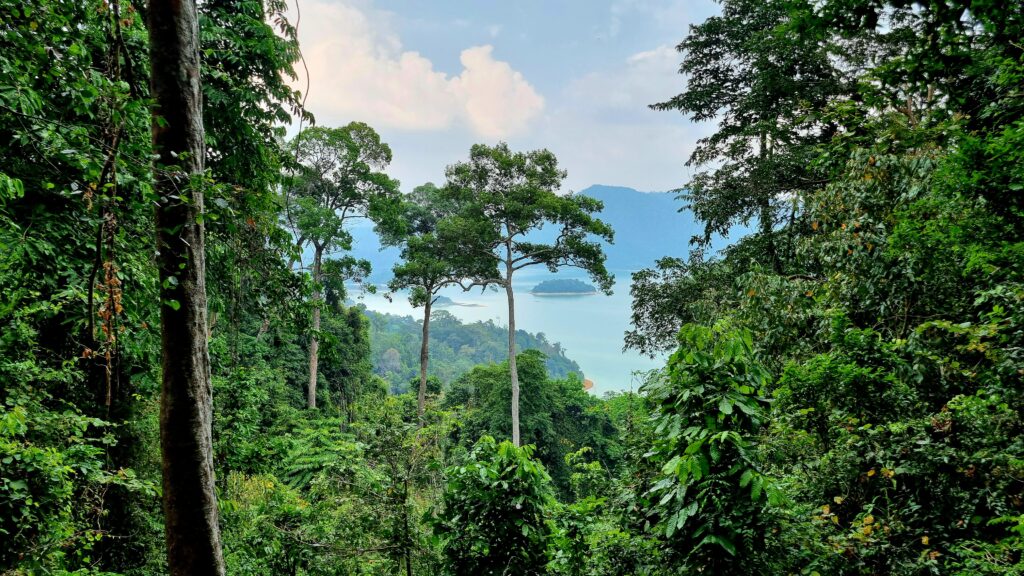
Author: Dragan Nikolić
There are journeys that take us to the far corners of the world. And there are journeys that take us straight into ourselves. I write these lines as someone who has had the privilege of seeing nearly every meridian, yet only now, among the tropical jungles and silences of Thailand, have I truly stepped into the hidden landscapes within me — the ones we rarely speak about and even more rarely discover.
At the end of March, thanks to the invitation of the Tourism Authority of Thailand (TAT), the Embassy of Thailand in Athens, and the Honorary Consulate of Thailand in Serbia, I had the honour of being part of a small international group of journalists from Serbia, Bulgaria, and Romania. The organization of the TAT office in Bucharest made this journey special — not as tourists, but as explorers of life itself.
Thailand welcomed us with wide-open doors and an even wider smile. Beyond Bangkok and the spectacular shores of the Andaman Sea near Phuket, we uncovered the secrets of the Khao Sok jungle, gazed at the karst formations rising from the sea like ancient sentinels on James Bond Island, and plunged into the azure expanse of the Similan Islands. And the longer I travelled, the clearer it became — Thailand is not merely an exotic destination from a postcard.
Far from the beaten tourist paths, Thailand offers something deeper. Something that cannot be packed in a suitcase or captured through social media filters. This Southeast Asian country offers its guests the chance to return to themselves: through the silence of temples, the simplicity of life, and the wisdom of Buddhist philosophy, which teaches us that true wealth is carried within our own hearts.
This journey was not just a journey to a new land. It was a journey back — to my own soul.
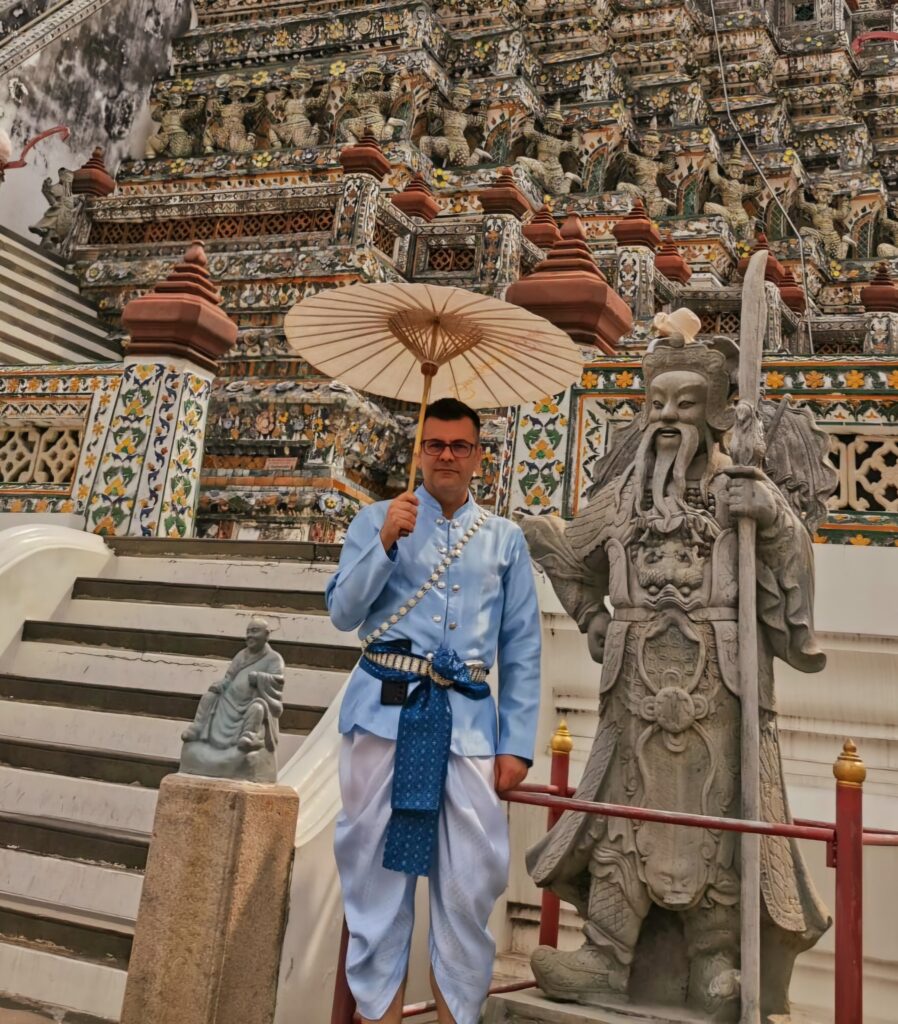
In Bangkok, we stayed at the luxurious Capella hotel, right on the banks of the Chao Phraya River. This mighty river, slicing through the city from north to south like a silver ribbon, carries within it an ancient wisdom — that every journey is both a departure and a return. Our hosts had prepared an experience far removed from the usual tourist routes. Within the Tourism Authority of Thailand (TAT), there is a special department dedicated to finding new ways of presenting Thailand to younger generations — and to all those young at heart — offering not brochures, but true experiences. Our first step was a drive through Bangkok in vintage cars, in the atmosphere of an old Hollywood movie. Seated on leather seats, with a picnic basket filled with champagne and spicy Thai delicacies, I watched the city glide past like a moving picture: tuk-tuks, motorcycles, a river of people and colours, the scent of street food filling the air. In that moment, I felt like a traveller through time, suspended between the present and some elusive, long-forgotten Bangkok.
Time stood still before the gates of Wat Arun. Our Thai hosts dressed us in traditional attire — bright fabrics, shimmering ornaments, parasols to shield us from the blazing sun. It was our first encounter with ourselves reflected in the mirror of another culture. We stepped into the courtyard of the temple dedicated to Arun, the symbol of spiritual rebirth and transformation.
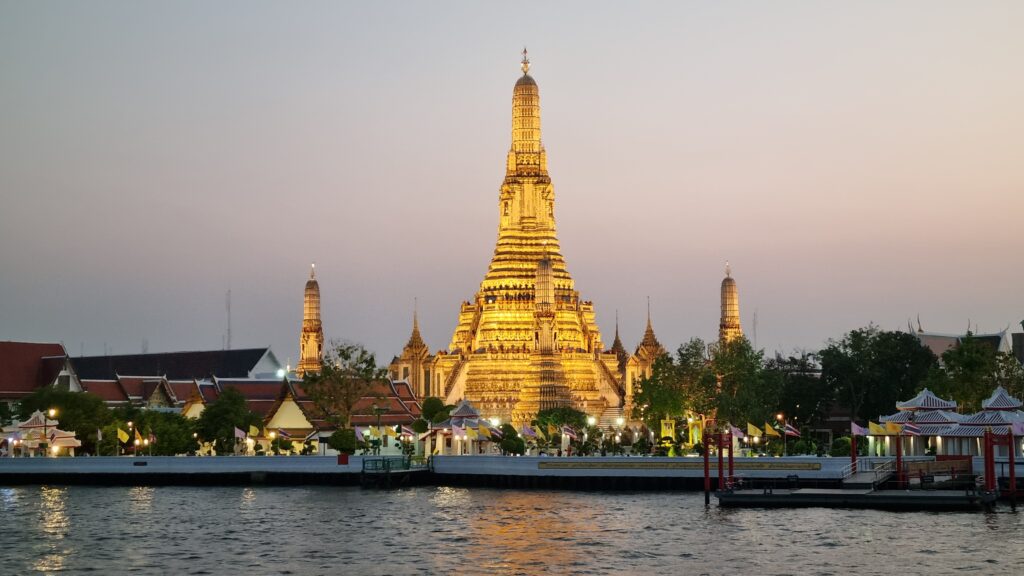 Did I understand the symbolism then? I did not. But it was precisely then, silently, imperceptibly, that my true journey began — a journey not towards new destinations, but towards new depths of my own soul. Transformation did not arrive with fanfare.
Did I understand the symbolism then? I did not. But it was precisely then, silently, imperceptibly, that my true journey began — a journey not towards new destinations, but towards new depths of my own soul. Transformation did not arrive with fanfare.
It came through play, through laughter, through the silk fabrics that wrapped around me and the vintage cars that gently carried me through streets that are never the same twice. And just as the Chao Phraya River flows tirelessly through Bangkok, a new river had already begun to flow within me — silent, invisible, yet unstoppable.
That evening, we sailed along the river on a cruise that wove together all the charms of Thailand — music, exquisite cuisine, and the vision of a city assembling itself before our eyes like a colourful mosaic. From the water, Bangkok seemed to pulse with its own rhythm, as the lights, temples, skyscrapers and narrow streets slowly merged their contrasts into a single, opulent whole. As our palates delighted in flavours impossible to find anywhere else in the world, I understood why Thai cuisine is considered one of the best — and if you ask me, the best.
Rooted in natural, wholesome ingredients, free from processed sugars and additives, Thai dishes work wonders for both body and soul.
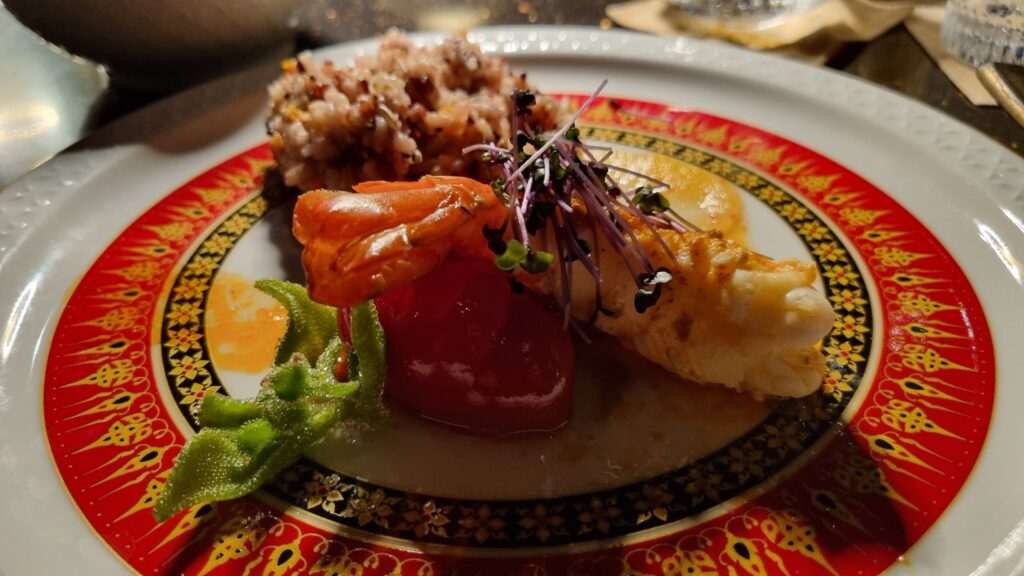 A bounty of tropical fruits and vegetables, a variety of meats, and an abundance of seafood were woven into every plate. The names of the dishes were impossible to memorise — not just because they were in Thai, but because the creativity of the local cuisine seemed endless.
A bounty of tropical fruits and vegetables, a variety of meats, and an abundance of seafood were woven into every plate. The names of the dishes were impossible to memorise — not just because they were in Thai, but because the creativity of the local cuisine seemed endless.
The spices were present, as expected, but carefully measured, for our hosts knew that not every guest from distant lands could endure the full heat of Thai flavours. The food was light, nourishing, and liberating — leaving space to enjoy both the view and the conversation, without the heaviness that often follows rich meals.
Our hosts, with that effortless grace that cannot be faked, had thought of every detail.
Noticing my fondness for cigarillos, they discreetly arranged for several locally made cigars to be brought to the boat. After dinner, they invited me to join them on the deck. There, beneath the Thai starry sky, amidst laughter and quiet conversation, I discovered a new side of this country — its art of attentiveness. With a fine, aromatic tobacco I had never known existed, I felt one of the rarest experiences travel can offer: the feeling of being at once a guest, a friend, and a part of a place that embraces you with an open heart.
Journey into the Rainforest
If Bangkok had stirred our inner selves, cracking the shells around us and letting something within begin to open, then venturing into the jungle was the moment of true rebirth. The Khao Sok National Park, home to the largest deciduous rainforest in the world, is not on the lists of typical tourists. Yet for those who seek themselves, it should be a sacred stop.
On our first day in the jungle, we stayed at Elephant Hills Camp. A gong sounded to announce meals, but its echo barely cut through the endless roar of jungle cicadas. The sound of the cicadas was no ordinary chirping — it was the roar of life itself, a relentless alarm as if to warn: here, different rules apply. An alarm was triggered. The inner one. It was time to face your fears. To accept your flaws, to recognise your strengths. There was no other choice.
Shoes had to be shaken out before putting them on. Water was drunk from canteens, refilled from large cooling vats placed under a wooden canopy in the camp’s centre. Mobile signal was weak, internet too, and the only sounds were the clinking of canteens as the few tourists made their way along the beaten paths to their tents. At nine o’clock, the lights were turned off, and you needed a torch if you had the courage to venture anywhere in the darkness.
Not far from the camp was a sanctuary for elephants — the gentle ones who had served humans, but now, due to age or illness, could no longer fend for themselves. If they were released into the wild, they would not survive. Thus, a camp was created where they are cared for, fed, loved — but not ridden. Those who come here do not expect to ride them; it would be against the very principles that brought them to this place.
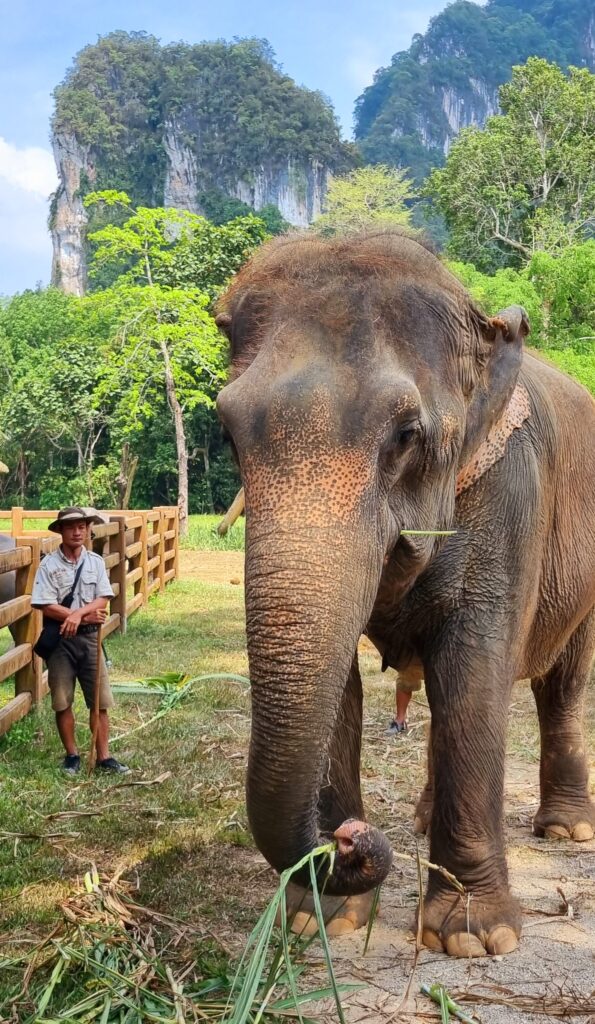
As we fed the elephants, they waved their trunks, trying to snatch one more piece of sugarcane. Saliva flew through the air; tourists laughed and drew closer to these great beings who know how to feel love — and, sadly, pain. Caring for the old and the vulnerable among nature’s creatures teaches us that we are blessed with what we have and what we are capable of. It reminds us that we are not weaklings, that we can survive any jungle — no matter its form. Most importantly, it teaches us solidarity and unity, not just with other people, but with nature itself and every living being it has created.
On the second day, we headed to Cheow Lan Lake, where we were accommodated in tents set up on barges. Here, there was no mobile signal or internet connection whatsoever. The nearest sign of civilisation was an hour and fifteen minutes away by boat. The conditions were strict but simple: respect them, and nothing would happen to you.
I had the opportunity to choose my tent. Each tent bore the name of a jungle animal. I chose the one named Sun Bear — a small bear marked by a patch on its chest resembling a rising sun. It was no random choice. The sun on the chest of that creature was my emblem, my sign that the path I had embarked upon led towards the light, no matter the darkness surrounding me.
It took me no more than five minutes to scan myself to the finest detail. You quickly realise: what you have — that is who you are. And nothing more. Nothing will attack you or devour you, unless you place yourself in that situation. A tiger will walk its own path if it is full, but if it is hungry and sees you, it will chase you. So you must stay invisible, or be faster. Can you? A big question to which we think we know the answer — of course not. That is why you must create an initial advantage; you must be on your own ground (and that ground, imagine, is the jungle — and yes, it belongs to you just as much as it does to the tiger, the elephant, or the python).
You know your capabilities and you behave accordingly. You rush nowhere, you lie low, you relax, you listen — so finely that you can hear even the tiniest insects in the tall grass, but also, for the first time perhaps, you hear your soul singing. You hear yourself. You see yourself. You know yourself. Yes, you exist, right here, among all these dangers. The jungle teaches you that danger is not in the danger itself. Danger lies in ignorance of yourself. And that was when I understood: cities are jungles too, places where you are attacked even when you are not wounded.
You sleep on the water, swim in the lake, paddle a canoe, balance on a paddleboard, hike through the jungle, gently touch a giant cave spider, and take care not to harm a harmless snake that, according to ancient beliefs, guards the treasure of the caves. You listen to the rain drumming on the giant leaves of unknown trees. You step around the droppings left by elephants. You follow tracks — others’ and your own — you observe the people around you, and you listen.
You breathe. You are alive and you will remain so, because you are powerful with all your flaws, strong in your imperfection, rich in your differences, cheerful and kind despite hardships, and warm — like the water of a bottomless lake.
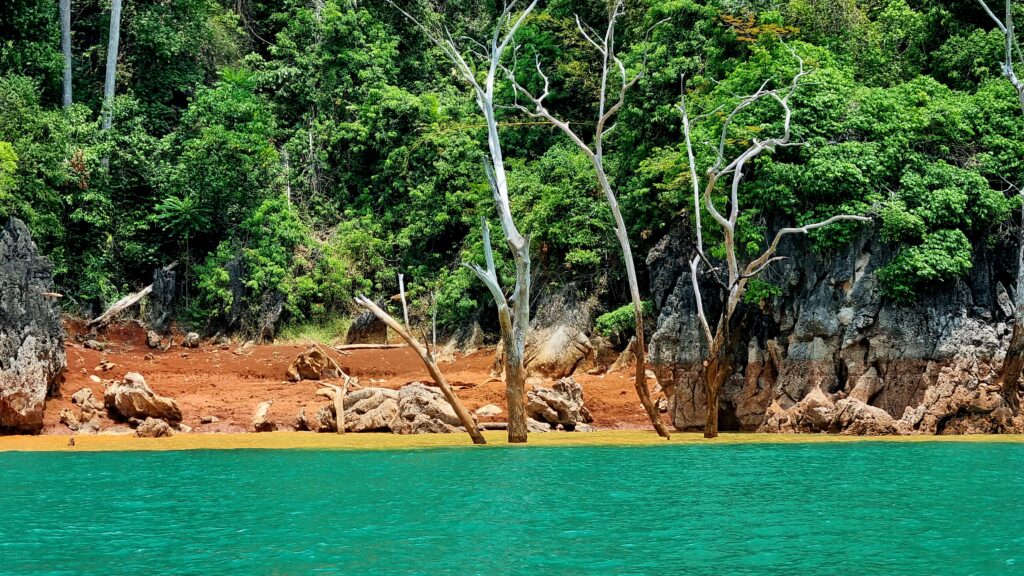
The Sea Remembers
Returning to everyday reality meant leaving the jungle behind. Knowing that much still lay ahead to be seen, we set off through the interior of Thailand, heading south towards the Phuket region. The road took us through rubber plantations, trees whose milky sap — latex — is processed into rubber. These trees release an oddly unpleasant smell, but their plantations are strikingly beautiful. Much like the durian — a fruit with an unbearable smell but an unforgettable taste, considered a true delicacy by the Thai people.
As we approached the shores of the Andaman Sea, palm trees became taller and denser, and it seemed as if the roar of the waves could be heard deep inland. We descended to the coast in the Khao Lak region, known for its picturesque tourist villages and resorts lined along long, wide sandy beaches. Unfortunately, neither the width of the beaches nor all the sand could absorb the force of one of the first tsunami waves of 2004, one of the deadliest natural disasters in human history. Hundreds of thousands of people lost their lives. The first wave struck precisely at Khao Lak, the most exposed part of the Malay Peninsula facing the epicentre in the Indian Ocean.
Some twenty kilometres inland, we saw a police boat — carried and abandoned there by the tsunami. Today, the site stands as a memorial, one of dozens scattered along the coast. One such memorial was located near our hotel, JW Marriott Khao Lak. At the end of the beach, within the bay, I came across a building — or rather, the skeletal pillars of what was once a three-storey structure, now without walls, windows, or doors. Only the sea breeze, carrying a rare freshness in this tropical paradise, passed through it.
On the building, a faded sign reads: Tsunami Memorial. Exactly twenty years ago, the tsunami completely erased life at this place — and in many others, across Thailand, Sri Lanka, and Indonesia. It was a wave that moved the planet. Here, precisely here, where the sand now scratches the soles of my feet, the first wave struck. It swept everything away — first deep into the land, and then back into the sea. It tore down the walls of this skeletal structure. Everything disappeared. What was once a famous resort, much like the one I had set out from for my walk, today remains only as a skeleton, a silent reminder of a biblical flood.
The forest behind the beach has since begun to resemble a jungle — a vital, resilient old man who, at some point, stopped shaving and became overgrown with vines and wild grass. I spot a bench, positioned directly opposite the skeletal remains of the building. Buried in the sand, it stands as the only testimony to human presence over the past twenty years. It faces the sea — the same sea that, once angered, swept away everything in its path. Everything vanished in an instant.
The bench now sits and gazes into the distance, listening to the sea to hear whether life still stirs within it, or whether death is once again preparing to scatter bones already left behind on the beach. I sit down as well, and I too watch. Thoughtful, I listen to the silence — the music of sorrow. Squirrels dart about. White birds with long beaks peck at small crabs in the sand, and flowers sway in the morning breeze from the open sea.
Everything is so still — everything has vanished, and yet everything is here once more.
That morning, the day before returning home, I experienced perhaps the most powerful impression of Thailand. I felt the strength of this land and its proud people, who have lived in harmony with nature for centuries, while at the same time bravely enduring its challenges — with smiles, with good energy, and with a kindness that speaks only one message: we are friends, and we shall meet again. Soon, of that I am certain.
The Similan Islands
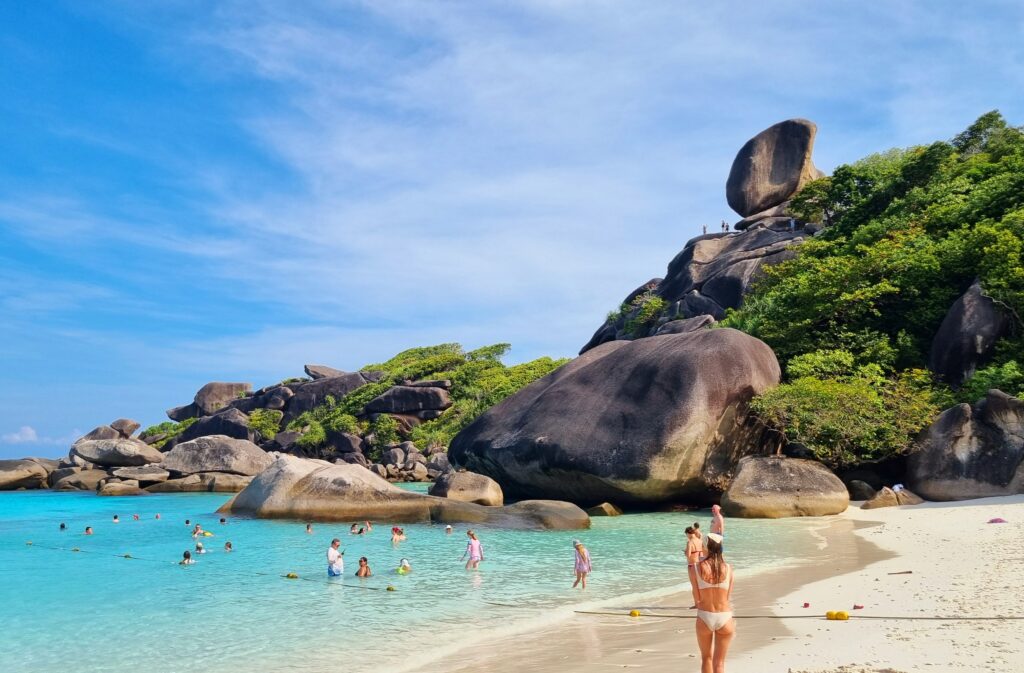
The Similan Islands are located in the Andaman Sea. The archipelago consists of nine islands (the word “Similan” means “nine” in the local Thai dialect), three of which are off-limits to visitors due to strict conservation measures, while one is a private island owned by a member of the royal family. The remaining islands are open to tourists, although the number of visitors is carefully regulated. These paradise islands are perfect for swimming, sunbathing, and enjoying untouched nature. Visitors often go snorkelling to observe colourful fish and large sea turtles, and whale sharks also inhabit the waters around the islands.
Phang Nga Bay
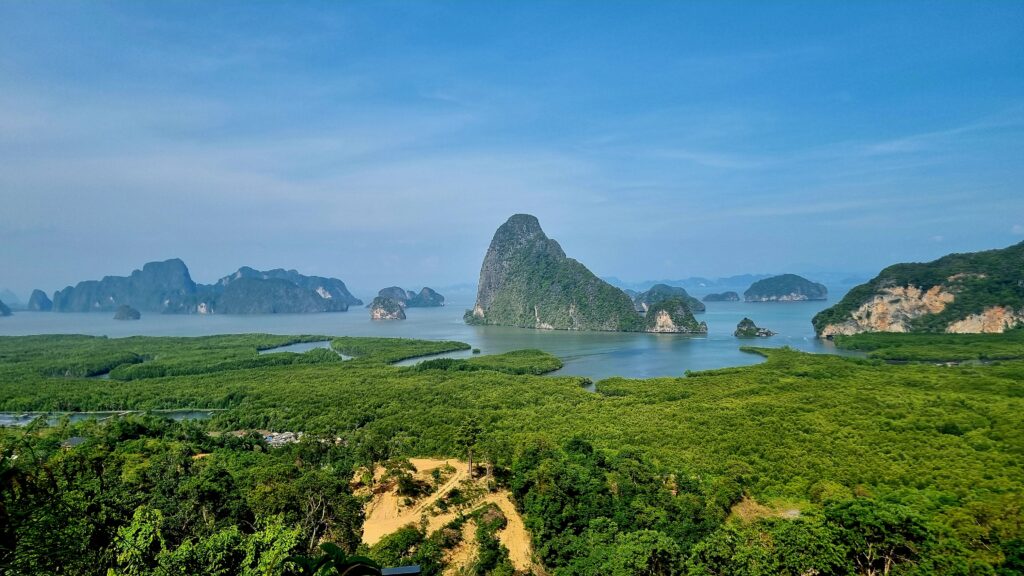 Phang Nga Bay, located in the Andaman Sea not far from Phuket, is best known for James Bond Island, where Roger Moore, as Bond, famously pursued the villain Francisco Scaramanga in the 1970s. This island is one of the most photographed places in the world, but unfortunately, it is also one of the most polluted. The sea is in a dire state, and the mangrove forests — which, together with the limestone peaks rising from the water, represent the bay’s greatest natural treasure — are now dying out. Visible in many photographs is also the Muslim village of Koh Panyee, built entirely on stilts.
Phang Nga Bay, located in the Andaman Sea not far from Phuket, is best known for James Bond Island, where Roger Moore, as Bond, famously pursued the villain Francisco Scaramanga in the 1970s. This island is one of the most photographed places in the world, but unfortunately, it is also one of the most polluted. The sea is in a dire state, and the mangrove forests — which, together with the limestone peaks rising from the water, represent the bay’s greatest natural treasure — are now dying out. Visible in many photographs is also the Muslim village of Koh Panyee, built entirely on stilts.
Capella Bangkok Hotel
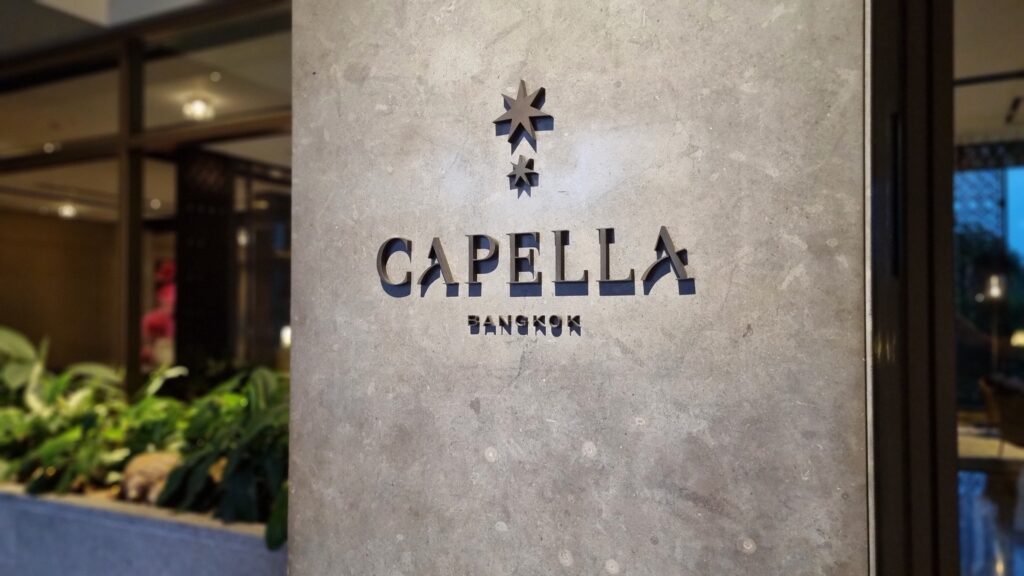 Capella Bangkok is a luxurious urban resort located right on the banks of the Chao Phraya River, in the historic Charoenkrung district. The hotel features 101 elegant rooms and suites, offering panoramic views of the river through floor-to-ceiling windows. Known for its restaurants such as Côte, led by Michelin-starred chef Mauro Colagreco, and Phra Nakhon, which serves authentic Thai cuisine, Capella also offers the Auriga Wellness Spa, inspired by ancient Asian rituals. A distinctive feature of the hotel is the Capella Culturists team, dedicated to creating unique local experiences for guests. In 2024, Capella Bangkok was named the best hotel in the world by The World’s 50 Best Hotels list.
Capella Bangkok is a luxurious urban resort located right on the banks of the Chao Phraya River, in the historic Charoenkrung district. The hotel features 101 elegant rooms and suites, offering panoramic views of the river through floor-to-ceiling windows. Known for its restaurants such as Côte, led by Michelin-starred chef Mauro Colagreco, and Phra Nakhon, which serves authentic Thai cuisine, Capella also offers the Auriga Wellness Spa, inspired by ancient Asian rituals. A distinctive feature of the hotel is the Capella Culturists team, dedicated to creating unique local experiences for guests. In 2024, Capella Bangkok was named the best hotel in the world by The World’s 50 Best Hotels list.
JW Marriott Khao Lak Resort & Spa
 JW Marriott Khao Lak Resort & Spa is located on the peaceful shores of Khuk Khak Beach, north of Phuket. The resort features 420 elegant rooms, suites, and villas, with direct access to the longest swimming pool in Southeast Asia, stretching 2.4 kilometres. Its culinary offering includes 11 restaurants and bars, ranging from authentic Thai and Japanese cuisine to Italian and Mediterranean specialities. Guests can also enjoy the Aqua Play Zone, the organic JW Garden, and the Quan Spa, offering treatments inspired by Asian rituals. A special highlight is the Bamboo Shark Nursery, a centre dedicated to the protection and conservation of rare marine species.
JW Marriott Khao Lak Resort & Spa is located on the peaceful shores of Khuk Khak Beach, north of Phuket. The resort features 420 elegant rooms, suites, and villas, with direct access to the longest swimming pool in Southeast Asia, stretching 2.4 kilometres. Its culinary offering includes 11 restaurants and bars, ranging from authentic Thai and Japanese cuisine to Italian and Mediterranean specialities. Guests can also enjoy the Aqua Play Zone, the organic JW Garden, and the Quan Spa, offering treatments inspired by Asian rituals. A special highlight is the Bamboo Shark Nursery, a centre dedicated to the protection and conservation of rare marine species.